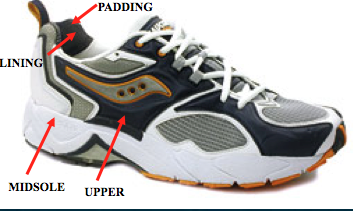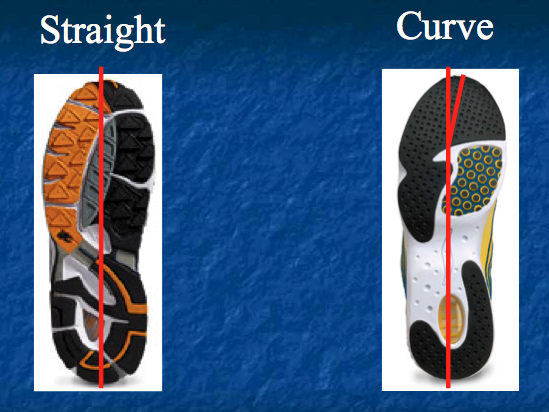Selecting and using the right running shoe is crucial for foot health and preventing lower limb injuries. The function of the running shoe, is to protect the foot from the stresses of running while achieving high performance for your activity.
People with low foot arches are called ‘Pronators’, they require shoes with stability. People with high arches are called ‘Supinators’, they require shoes with more cushioning.
Below is an overview of the 3 main features to consider when choosing a running shoe: shape, construction and midsole
Shape
To find out the shape of the shoe, look at its sole. Draw a straight line from the middle of the heel to the top of the shoe. If the line is curved, this shoe is more comfortable for ‘Supinators’. If the line runs straight through the middle of the toes, the shoe is more comfortable for ‘Pronators’ and adds stability
Construction
If you take out the insole and look at the inside of the shoe, you can take a look at the stitching and construction of the shoe. In ‘Board’ constructed shoes the bottom of the shoe will not have any visible stitching; these are built specifically for pronators. ‘Combination’ shoes will have stitching beginning half-way, and can be worn by pronators or supinators. Finally with ‘Slip’ constructed shoes, you will see stitching running the entire length of the shoe; this provides the flexibility in the shoe needed for supinators
Midsole
A lot of the cushioning and stability of the running shoe is determined by the midsole. There are two main types of midsoles. The ‘Single-density’ midsoles offer good cushioning but do not have great stability, this makes them better for supinators. ‘Dual-density’ midsoles provide shock absorption as well as stability and are good for pronators.
Consult a chiropractor if you have any questions regarding the construction or shape of your running shoe, and whether it is appropriate for you. This information can prevent running-related injuries.
People with low foot arches are called ‘Pronators’, they require shoes with stability. People with high arches are called ‘Supinators’, they require shoes with more cushioning.
Below is an overview of the 3 main features to consider when choosing a running shoe: shape, construction and midsole
Shape
To find out the shape of the shoe, look at its sole. Draw a straight line from the middle of the heel to the top of the shoe. If the line is curved, this shoe is more comfortable for ‘Supinators’. If the line runs straight through the middle of the toes, the shoe is more comfortable for ‘Pronators’ and adds stability
Construction
If you take out the insole and look at the inside of the shoe, you can take a look at the stitching and construction of the shoe. In ‘Board’ constructed shoes the bottom of the shoe will not have any visible stitching; these are built specifically for pronators. ‘Combination’ shoes will have stitching beginning half-way, and can be worn by pronators or supinators. Finally with ‘Slip’ constructed shoes, you will see stitching running the entire length of the shoe; this provides the flexibility in the shoe needed for supinators
Midsole
A lot of the cushioning and stability of the running shoe is determined by the midsole. There are two main types of midsoles. The ‘Single-density’ midsoles offer good cushioning but do not have great stability, this makes them better for supinators. ‘Dual-density’ midsoles provide shock absorption as well as stability and are good for pronators.
Consult a chiropractor if you have any questions regarding the construction or shape of your running shoe, and whether it is appropriate for you. This information can prevent running-related injuries.




